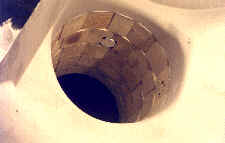
| Chemical analysis | |
|---|---|
| Al2O3 | min. 50% |
| SiO2 | min. 46% |
| Fe2O3 | min. 2% |
| Others | max. 2% | Thermal conductivity |
| 200℃ | 0.18W/mK |
| 300℃ | 0.21W/mK |
| 400℃ | 0.22W/mK |
| 600℃ | 0.27W/mK |
| 800℃ | 0.30W/mK |
| 1000℃ | 0.34W/mK |
| 1200℃ | 0.38W/mK |
| Crushing strength | |
| 2MPa | |
| Specific Heat Capacity | |
| 919.6J/kg/K | |
| ISOTHERM "Z" cycloid element | Dimensions | Pieces of cycloid elements per pallet |
|---|---|---|
| Z 1 | 30mm x 115mm / 123mm x 200mm | 936 pieces |
| Z 2 | 30mm x 115mm / 123mm x 300mm | 702 pieces |
| Z 3 | 45mm x 115mm / 127mm x 200mm | 612 pieces |
| Z 4 | 45mm x 115mm / 127mm x 300mm | 459 pieces |
| Z 5 | 65mm x 148mm / 165mm x 200mm | 320 pieces |
| Z 6 | 65mm x 148mm / 165mm x 300mm | 240 pieces |
| Z 7 | 75mm x 250mm / 270mm x 300mm | 126 pieces |
| Z 8 | 75mm x 250mm / 270mm x 400mm | 84 pieces |
| Z 9 | 95mm x 250mm / 270mm x 300mm | 99 pieces |
| Z 10 | 95mm x 250mm / 270mm x 400mm | 66 pieces |
| Z 11 | 120mm x 200mm / 240mm x 300mm | 96 pieces |
| Z 12 | 120mm x 200mm / 240mm x 400mm | 93 pieces |
| Z 13 | 160mm x 200mm / 240mm x 300mm | 75 pieces |
| Z 14 | 160mm x 200mm / 240mm x 400mm | 57 pieces |
| Z 15 | 180mm x 200mm / 240mm x 300mm | 60 pieces |
| Z 16 | 180mm x 200mm / 240mm x 400mm | 40 pieces |
| Z 17 | 200mm x 200mm / 240mm x 300mm | 60 pieces |
| Z 18 | 200mm x 200mm / 240mm x 400mm | 40 pieces |
The modulus enlargement is 1.45.
If the cycloid elements are used for risers with smaller solidification modulus, than the recommended modulus enlargement factor is increased.
In the following tables suggest assembles of ISOTHERM "Z" cycloid elements types Z 1 - Z 8 into various feeders sizes. Further the geometrical modulus (M = V/o) as well the solidification modulus (M = V/o*f) are indicated.
Increasingly during calculation of the casting modulus, foundries take the shape factor into consideration, we therefore also indicate the solidification modulus.
Shape factor makes modulus from f = 1.0 - 1.17 dependent on the shape of the casting, the savings resulting from this are being exploited more and more foundries. To save calculation time, we indicate both modulus.
Instructions for use
For economic reasons it is necessary to base calculations on the solidification modulus as it contains the shape factor. This results in a more than 10 % saving on some castings on plate-shaped castings in which the geometrical modulus is practically equal to the solidification modulus. When determining the riser it must be considered that the solidification modulus of the riser is 8 - 11 % higher than its geometrical modulus. In foundries where experienced technicians provide details of size and positions of feeders these technicians should reduce their normal sand feeders smaller insulated feeders outlined in the tables. In doing however attention must be paid to the shrinkage volume.
It is an advantage to have these feeders or feeder rings prepared by an assistant, so that the moulders receive the assembled feeder linings ready for us.
ISOTHERM "Z" cycloid elements are unaffected by changes in temperature and can therefore be dried with the mould at as high a temperature as required. Consequently there is no subsequent fitting work on the finished moulds. The feeder lining seat reliably in the moulding sand, and the liquid steel can neither lift or flow round them. As the ISOTHERM "Z" compound does not produce any gases on contacts with the liquid steel, there is no formation of smoke or any reaction with the steel. The ISOTHERM "Z" cycloid elements present an ideal solution to the acute question of environmental protection, as their application is extremely compatible with the environment.